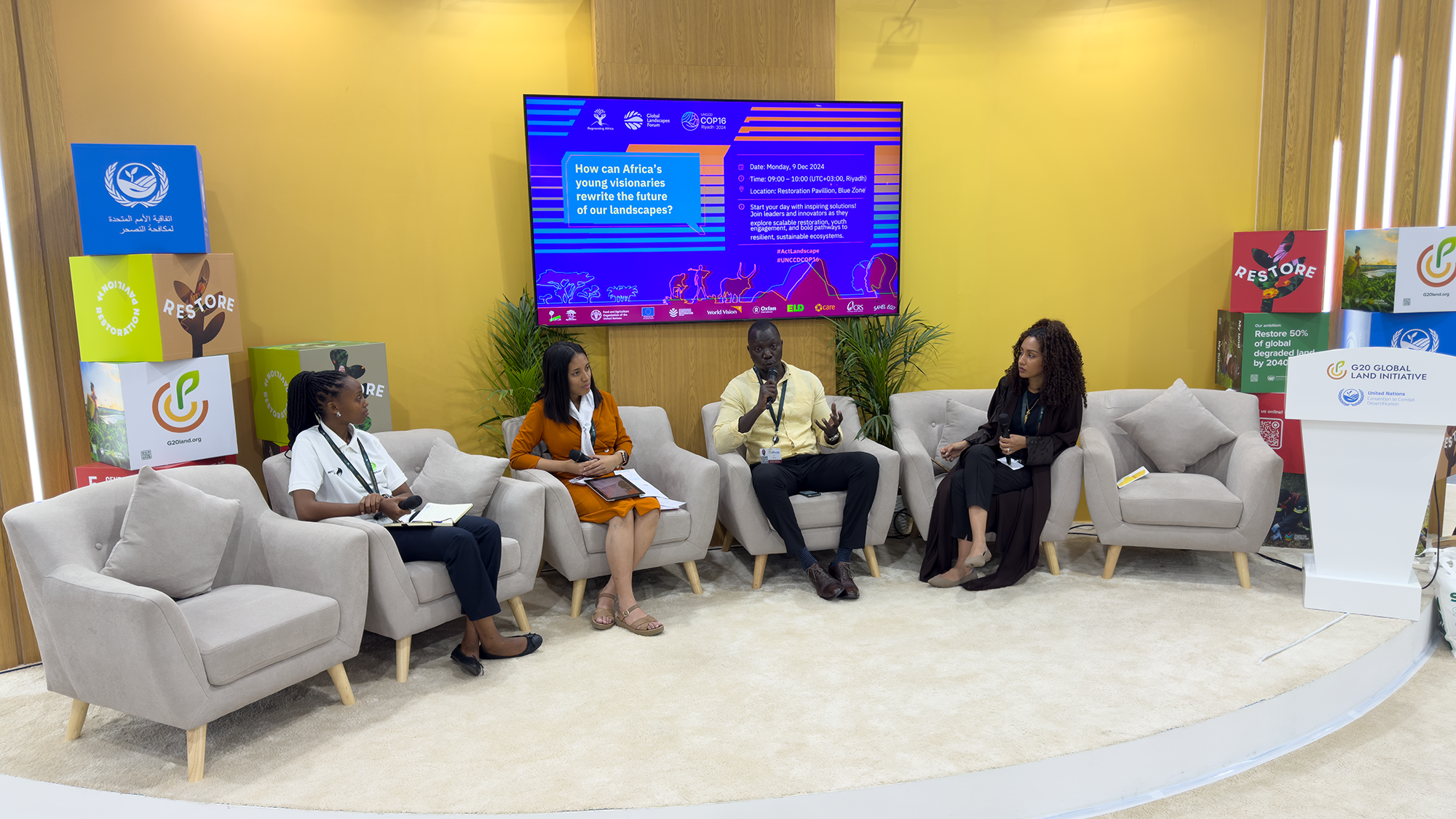Restoration Pavilion sparks innovative conversations on land restoration at UNCCD COP16

Young land restorers from Africa at the Restoration Pavilion during UNCCD COP16, on 9 December 2024, in Riyadh, Saudi Arabia.
Photo credit: UNCCD/G20 Global Land Initiative
The Restoration Pavilion, organized by G20 Global Land Initiative, continued to ignite discussions on land restoration at the UNCCD COP16, bringing together innovative ideas and transformative solutions.
Day six featured an exciting lineup of seven sessions, engaging a diverse audience with cutting-edge strategies to combat land degradation and promote sustainable practices.
A high-level event, Enhancing data capacity, availability and analytics for land and forest degradation, desertification and drought monitoring, underscored the pivotal role of data-driven approaches in combating land degradation.
Experts presented innovative methodologies, such as integrating satellite imagery and real-time analytics to monitor droughts, desertification and deforestation. The session highlighted the critical need for reliable and scalable data systems to inform policy decisions and foster effective land management strategies globally.
Participants witnessed two report launches:
- How are young visionaries rewriting the future of Africa’s landscapes? celebrated the bold initiatives of Africa’s youth in transforming degraded lands into thriving ecosystems. The session showcased innovative projects that integrate traditional practices with modern restoration techniques, creating sustainable livelihoods while enhancing biodiversity.The report, Rooted in restoration Youth-led transformative change for regreening Africa highlighted the shared experiences of young land restoration practitioners in the continent, detailing their challenges, solutions and hopes for the future, calling to empower young leaders in restoration.
- Global Restoration Commitments and Pledges: 2024 Report provided a detailed analysis of the changing scenario in international commitments to restore land. It spotlighted the source of the additional over 200 million hectares pledged for restoration, mostly from the three sister Rio Conventions.Working via the findings of this pulse-taking report, the session offered valuable insights into the countries that offer the fastest pathway to achieving most of these commitments by 2030.Participants also learned about the large stock of historical data available to assess progress in restoration globally and the rapid improvements in data monitoring tools that will enable the international community to track changes and monitor and assess progress in land restoration more accurately. Participants left with renewed motivation to strengthen collaborative efforts.
Other sessions included:
- Digital technologies: a boon for drought management, which delved into the potential of advanced technologies to revolutionize drought resilience. Panelists demonstrated tools such as AI-powered drought prediction models, real-time water monitoring systems and mobile platforms for farmer advisories. These innovations not only mitigate drought impacts but also enable communities to adapt to changing climatic conditions more effectively.
- Advancing Restoration through Research and Innovation: The KSA Native Plant Genome Pilot Project spotlighted Saudi Arabia’s groundbreaking research in native plant genomics. By sequencing and analyzing the genomes of indigenous species, researchers aim at enhancing drought tolerance and ecosystem resilience. The session emphasized the critical role of science in creating tailored restoration strategies for arid regions, driving ecological and agricultural benefits.
- Initiatives in Conservation and Soil Rejuvenation explored strategies for reversing soil degradation through conservation agriculture and organic soil amendments. Speakers presented case studies from diverse geographies, showcasing methods like agroforestry, cover cropping and biochar application. These practices enhance soil health, boost crop yields and contribute to carbon sequestration, presenting a multifaceted approach to sustainable land use.
- Leveraging Digital Innovations for Effective Land Restoration: Showcasing Advanced Technologies and Successful Case Studies demonstrated the transformative power of technology in restoration efforts. From drone-assisted reforestation to blockchain platforms for tracking restoration investments, the session provided attendees with a rich array of practical tools and success stories. These digital innovations were shown to increase restoration efficiency, transparency and scalability, offering new ways to meet global restoration goals.
Panelists at the Pavilion emphasized the intersection of research, technology and community-driven practices to achieve sustainable restoration, all underscoring the fundamental need to develop a common language for gathering, processing and governing data that is transparent and helps further the accountability agenda.
The Restoration Pavilion continues to offer an unparalleled platform for knowledge exchange and innovation through in person or virtual sessions. The events at the Pavilion run until 11 December 2024.




